Primrose House
Around 1920, some businessmen from Lowell, Massachusetts met the advertising copywriter Helen Rosen Woodward about setting up a cosmetic business. This meeting would lead to the establishment of Primrose House.
Lowell investors
The businessmen had no specific interest in, or knowledge of, cosmetics. Their aim was to repeat the financial success of fellow Lowell residents – such as James Cook Ayer (Ayer’s Sarsaparilla) and Humphrey O’Sullivan (O’Sullivan’s Rubber Heels) – who had made fortunes selling products through national advertising campaigns. They were looking to invest in a consumer product that could be sold in bulk nationwide and in the early 1920s cosmetics looked to be a good bet.
Helen Rosen Woodward
Helen Woodward was persuaded to develop the idea in return for common stock in the new company.
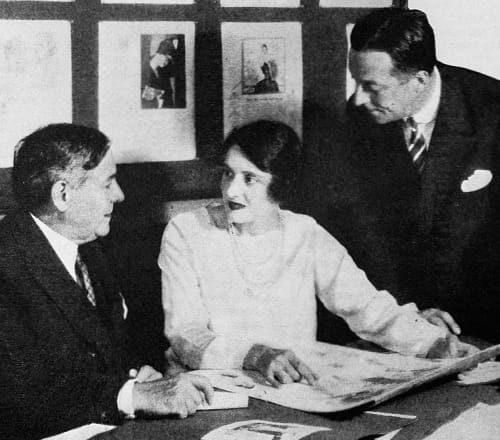
Above: Helen Rosen Woodward [1882-1960]. She worked as a copywriter for Presbrey & Gardner before retiring in 1924.
Her research into the cosmetics business suggested that establishing a mass-marketed line would required a prohibitively expensive advertising campaign but a luxury, salon-based line could be developed more reasonably.
When I examined the cosmetics business for them, I found that there are two ways of going about it. There are concerns which sell one or two cold creams of face powders at a low price, in enormous quantities, through drug and department stores. These are direct, commercial enterprises, advertising widely and selling at a moderate price. The other way is much more subtle and indirect. The companies which employ the second method deal in large numbers of creams, powders, rouges, lotions—each for its own little purpose—and all very high priced. These companies operate in an atmosphere of elegance and illusion, which enables them to charge fantastic prices—to add from five hundred to a thousand per cent to their costs.
I learned that it would cost about three hundred thousand dollars to put on the market a low priced set of cold creams, while the more luxurious array could be started on its road for about sixty thousand dollars.(Woodward, 1926, pp. 304-305)
Woodward produced a plan and put it to the Lowell investors. It had three main components: the cosmetic company would sell a wide range of luxurious cosmetics; it would be centred around a salon situated in New York at a place that would attract national attention; and a woman with high social standing would be engaged as the nominal head of the company (Woodward, 1926, p. 305). The Lowell businessmen were delighted with the outline, raised the money to put it into action – including some from Helen Woodward – and founded The Lowell Company in 1921 to develop the new concern.
The Lowell Company
Most of the US$100,000 seed money was raised in Lowell so the company was based there. The president, Robert F. Marden, was a banker whose primary interest was in the Morris Plan Company, a bank in Lowell. Vice-presidents were Frank B. Kenney, a Lowell cotton manufacturer; William E. Woodward, the husband of Helen Woodward; and Elsie Waterbury Morris, a New York socialite who had the necessary social credentials. The treasurer and clerk was John H. Murphy, also from the Morris Plan Company.
Elsie Waterbury Morris was to head the salon which was established in New York. As well as her good social standing she was the wife of Gouverneur Morris IV [1876-1953], a well-known author and playwright, so was likely to generate a lot of free publicity if she went into business. A booklet – ‘Beauty for Every Woman’ – supposedly written by her, was published by McCall’s Magazine to give her credentials as a beauty authority.
Mrs. Morris believes in beauty as a science. – “I believe that woman should give the impression of beauty, both spiritual and physical, and that her success will depend largely on her ability to keep fit,” says Mrs. Morris. “The love of her husband and the adoration of her children are to a great extent dependent upon the picture she creates. “Because we have been slow to realize the Importance of this factor, beauty, we have two types, both run riot: The girl on the street her face slathered with paint and the type of woman who seems to fancy that any individuality in the form of physical beauty must necessarily be wrong, or who, in a spirit of egotistic self-sacrifice, endeavors to make herself look as much like an Eskimo as she can! “I know from personal observation,“ continues Mrs. Morris, “that to look fit, happy, cleanly, beautiful, gives to a woman the necessary courage to face the everyday practical problems of life. “I am sure that preaching of the right sort of thinking, physical fitness, courage, Christianity is not confined solely to the pulpit but can be taught even from the lowly beauty parlor.
(Vancouver Daily World, November 7, 1921, p. 7)
The company also engaged the services of Lucille Buhl Bonanno. Lucille had been working for Elizabeth Arden but given Arden’s micromanagement style and famous temper it probably did not require much to persuade her to jump ship. Lucille provided technical advice for the new company and also assigned to it a patent for a Face Molder (US: 1443725) widely used in early advertising for Primrose House.
Salon
It was hoped to set up the New York salon on Fifth Avenue but a site at 3 East 52nd Street was selected instead. As well as being near to Fifth Avenue, the building had an architectural style taylor-made to attract attention, thus fulfilling one of Helen Rosen’s stipulations for setting up a successful beauty business.
The salon was reached through a red lacquered door situated at street level. This opened to a private stairway that led up one flight to a reception room filled with soft comfortable chairs. There clients could relax, sip tea and read fashion magazines while waiting for their appointment.

Above: 1921 The Reception Room at Primrose House. Decorated in vermillion and apple green, with purple, lavender, green and turquoise cushions, tall lamps and Italian tables and cabinets. Elsie Waterbury Morris may have helped with selecting the furnishings.
A beauty expert would analyse the client’s skin and then pass her to a nurse who would carry out the required treatment.
The manner of the nurse and the reclining chair soothe you at once. At your right stands a little table filled with delicious jars and bottles, with little bowls of hot water and other bowls of ice.
The nurse dips a little sack of almond meal, orris, and oatmeal into hot water, and passes it swiftly over your face. Over the bowl of ice she pours a lotion smelling of roses and violets. Into this icy odorous mixture, pungent with alcohol, she dips white balls of cotton batting. And then in precise, swift, and calm succession creams and liquids, oils and medicinal salves—all icy cool—are applied to your face. The nurse does not talk, except to say at just the right moment, “This cream I am now using is heavier; your skin needs food.” Or, “This tonic is very stimulating to a tired skin.” Then the light is turned off and the nurse disappears, while you relax in complete sleepy nothingness.(Woodward, 1926, pp. 310-311)
Face molding
The signature procedure for Primrose House was ‘Face Molding’. The treatment helped generate interest and also distinguished Primrose House from companies, like Elizabeth Arden and Dorothy Gray, that used patters, or others, such as Helena Rubinstein and Richard Hudnut, that relied primarily on massage.
Despite its claims not to use massage, which was said to ‘stretch the skin’ and ‘break down tissue’, the Primrose House Face Molding Treatment included a light facial massage routine. After applying the Face Molding Cream, which provided nourishment, fingers were used to apply pressure to the muscles of the face in an upward direction. This was said to strengthen the facial muscles and improve their elasticity, banishing the flabbiness and wrinkles that resulted from lax facial muscles. To make sure the facial muscles were strengthened, molding was followed with astringents, a common muscle firming treatment of the time.
Clients could also do face molding at home using the Primrose House Face Molding Set. This consisted of a muscle chart and the Face Molder, a device developed by Lucille Buhl to press Balsam Astringent into the skin over the Face Molding Cream.
The Face Molder: “[T]o be used in home treatment, in an ingenious device for exercising and firming the muscles thus restoring their youthful elasticity. It fits every angle of the face and neck and when using it there is no danger of stretching the skin or breaking down tissue.”
If deep wrinkles and hollows were present then the stronger Balsam Tissue Stimulant was used instead.

Above: Primrose House Face Molding Set.
See also: Face Moulding
Products
Elsie Waterbury provided the press with a fanciful story about how the Primrose House preparations were developed:
You know I have worked over the ideas Primrose house is carrying out for a long time. I have collected beauty preparations from all over the world and put them into use here. My fiends and I had many favorited preparations of our own—recipes we’d found in Paris or the East; something a skin specialist had prescribed, something grandmother had used when she was a girl in Virginia or something an English maid had brought from Surrey. Now we have pooled all these, our favourite beauty secrets. We have had specialists work on them, test them and here they are.
(The Sunday Oregonian, 1921, p. 5)
These snobbish values were also used in company advertising.
Of course, you know how Primrose House came to be. A group of women, led by Elsie Waterbury Morris, who have spent years and thousands of dollars in acquiring information in regard to beauty—for their own use—decided to go into business with this information as their capital.
(Primrose House advertisement, 1922)
Leaving this marketing blurb to one side, the fifty or so cosmetics in the original line must have been created in a relatively short period of time, something that reflects well on the unknown New England private label companies that developed them.
Skin-care
The skin-care principles followed by Primrose House were fairly standard for the time. They relied on the idea that the face and skin were a good deal more plastic than we would credit today, so manual therapies could improve circulation, skin foods could build up tissues, astringents could firm and tighten muscles, and chin straps could correct double chins and sagging throats.
See also: Straps, Bandages and Tapes, Skin Foods and Skin Tonics, Astringents and Toners
The Primrose House skin-care line in the 1920s covered most of the important areas. It made allowances for Dry, Normal, and Oily skin types, had day and night treatments, and included special preparations for common skin problems such as freckles, blackheads, and acne. The treatments followed the standard pattern of the day namely cleansing and toning the skin followed by a skin food. There were also the usual muscle oils, bleaches, pore refining and foundation/vanishing creams.
Rose Leaf Cleansing Cream: “This delightful cream, which liquifies readily, is invaluable for removing all surface impurities and cleaning the pores.”
Smoothskin Cream: “For the woman with an unusually dry and sensitive skin this is the perfect cream, light, non-fattening, with just a trace of perfume.”
Face Molding Cream: “It has exactly the right consistency for the molding process, and is rich in fine nourishing oils.”
Developing Cream: “This unusual cream is rich in fat producing and tissue building compounds.”
Bleach Cream: “An excellent cream for toning snd clearing the skin … For discolouration, freckles and brown spots on the face.”
Porefiner Cream: “This astringent cream is extremely valuable in the treatment of enlarged pores.”
Blackhead Pack: “[W]ill prevent as well as remove blackheads and it will refine and beautify the skin.”
Primrose House Skin Freshener: “A mild refreshing astringent for toning up the skin.”
Balsam Astringent: “A stronger astringent which keenly penetrates the pores, tightening the skin with amazing precision.”
Balsam Tissue Stimulant: “This stimulating oil sinks freely into the pores and reaches the undernourished tissue beneath.”
Eye Wrinkle Cream: “Copes most effectively with those annoying little wrinkles around the eyes due to fatigue, laughter or eye strain.”
Acne lotion: “For irritations of the skin, pimples and eruptions, caused by neglect or ill-treatment.”
Other products included preparations for tired eyes; oils and lotions for the hands and feet; nail polish and remover; chin straps; depilatories; bathing salts, powders and oils; and assorted shampoos and tonics for the hair.
Lemon Balm: “Hands pale and lovely as a lotus blossom are the gift of this exotic cream.”
Hand Cream “[A] faintly fragrant finishing cream in pure jelly form. Use it always after washing the hands to counteract the effect of soap, and always before going out.”
Special Lotion: “To whiten and beautify the hands.”
Face and Neck Rest Strap: “For correcting flabby muscles of face and neck. and heaviness under the chin. It is pleasant and comfortable to wear.”
Prim: “[A] scientifically perfected preparation for removing superfluous hair, particularly for the face.”
Primrose House Bath Oil: “[A] pure, very fine oil, delicately scented, to be rubbed over the body after the bath.”
Primrose House Hair Tonic: “[B]ought back hair almost entirely destroyed &hellip life giving to the scalp—gloss giving to the hair.”
Some assistance was provided for younger clients through the Primrose House Debutante Kit which consisted of Debutante Cream, Rose Leaf Cleansing Cream, Skin Freshener, and Chiffon Face Powder.
Debutante Cream: “So delicate—so exquisitely fine is the wild-rose colored cream, that it can be used on a Baby’s skin. It nourishes the skin tissues and keeps them healthy and firm.”
Make-up
The Primrose House make-up range from the 1920s included foundations, loose and compact face powders; a liquid powder; compact, cream and liquid rouge; lipstick; a cream kohl that could also be used as an eyeshadow; and an eyeliner. Each product came in a limited but serviceable range of shades.
Foundation Cream: “An ideal preparation for protecting the skin and providing a base for powder.”
Chiffon Face Powder: “The leading powder of Primrose House. It is quite unsurpassed in fines and delicacy.” Shades: White, Natural, and Brunette.
Face Powder: “An unusually fine powder.” Shades: Cream-White, Natural, Light Brunette, Dark Brunette, and Suntan.
Evening Face Powder: “Brilliant artificial lights at night make a different shade of powder desirable. Just the subtle, alluring softness is provided by this orchid tinted powder”
Petal Bloom Finishing Lotion: “A dainty lotion to be used under powder to give the skin a soft and even smoothness. Or may be used as liquid powder, obviating the necessity of the powder puff.” Shades: Cream-White, Natural, Light Brunette, and Dark Brunette.
Pomegranate Cream Rouge: “May be used on the lips as well as the cheeks.” Shades: Blonde (Light), and Brunette (Dark), with Medium added later.
Prim-Ora Rouge: “[A] fascinating creamy orange-like shade. It may be applied easily and is practically indelible.”
Rose Petal Rouge: “This delightful liquid rouge imparts the radiant glow of health to the skin and no matter how strenuously one motors, golfs, or even swims. … [W]ill remain until it is removed with cream.”
Spiral Lipstick: To outline the lips beautifully and give them just that touch of color that makes them so attractive. The convenient spiral container is triple gold-plated. Shades: Light, Medium, and Dark.
Ko-Hul: “An exotic and unusually effective preparation for making the lashes dark and luxuriant. This cream also darkens the lids to just the right extent.” Shades: Brown, and Black, with Blue, Violet and Green added later.
Mascara: Shades: Brown, and Black, with Blue added later.
Eyebrow Pencils: Shades: Brown, and Black.
See also: Here Dwells Youth. (c.1928)
Friction and separation
Things went well at first, with The Lowell Company even paying its stockholders a dividend, but there was an underlying disconnect between the operation that the three women – Woodward, Waterbury, and Buhl – had established and the aims and objectives of the Lowell businessmen. The men were really interested in establishing a mass-marketed business and did not understand the dynamics of maintaining a luxury salon-based line – a mistake also made by the Lehman Brothers when they bought the American business of Helena Rubinstein in 1928.
See also: Helena Rubinstein
Once the Primrose House salon and line were established, the men began cost-cutting. These changes saw Helen Woodward replaced by the advertising agency Hewitt, Gannon & Company in 1922, the subsequent dismissal of both Elsie Waterbury and Lucille Buhl, and new management installed in 1926.
Most of the disagreements arose because they wanted to take away from the business the subtle atmosphere which we had so painfully and carefully developed and without which our products would be worth no more than any other creams on the market. So friction grew until the situation became intolerable. Finally they took the advertising away from me while I was in Europe and unable to do anything about it. They gave the account to a little agency, which, whatever its qualifications, had not even a woman copywriter and no experience in selling any kind of beauty products. From that time on the advertising became merely a vulgar paraphrasing of what had been done before. A year later they discharges Mrs. Morris abruptly and rudely, and a few months afterward they also in equally rude fashion discharged Mrs. Buhl.
(Woodward, 1926, pp. 322-323)
The dismissal of Lucille Buhl may have been the reason why the Face Molder and Face Molding Cream were downplayed after 1928. The Primrose House skin-care routine for Normal skin then became more like any other – cleansing, nourishing and toning (bracing), followed by make-up.
Follow these four Primrose steps to Youth
1—Perfect cleansing is the first step to a beautiful skin. With a bit of absorbent cotton, squeezed out of cold water—or with the finger tips if you prefer—smooth Rose Leaf Cleansing Cream generously over the face and neck. Always begin at the base of the throat with long, light strokes spread the cream upward over the face. Then remove with tissues or a soft cloth.
Rose Leaf Cleansing Cream is the lightest of oil creams. It penetrates the film of natural oil that accumulates on the skin, takes up every particle of dust and make-up, and leaves the pores free so that skin may breathe.
2—Now the skin is in a receptive condition for the second step—nourishing. To keep your skin vital, supple and unlined, once a day mold Primrose Smoothskin Cream over your face and throat. Mold the cream gently into the skin for four or five minutes until the skin can absorb no more. Then remove with a soft cloth. You will be amazed at the new life this cream brings to your skin. 3—Now make a fresh pad of cotton and saturate it with Primrose Skin Freshener. Go over the face and throat with a brisk upward sweep. Skin Freshener is a mild, bracing and toning lotion that closes the relaxed pores and refines the skin texture.
4—And last—a bit of rouge, if you need it. Then finish with Primrose House Chiffon Powder—the most luxurious face powder you have ever known. It gives the skin a natural bloom that lasts for hours.(Primrose House advertisement, 1929)
It seems clear that the new management had plans to extend the reach of Primrose House. A west coast branch was established at 127 Grant Avenue, San Francisco in 1927; the wholesale business was moved to 49 West 45th Street, New York in 1928 and larger product sizes were introduced; the salon was relocated to 595 Fifth Avenue, New York in 1929; and European trademarks were taken out in 1928, as a preliminary for overseas expansion.
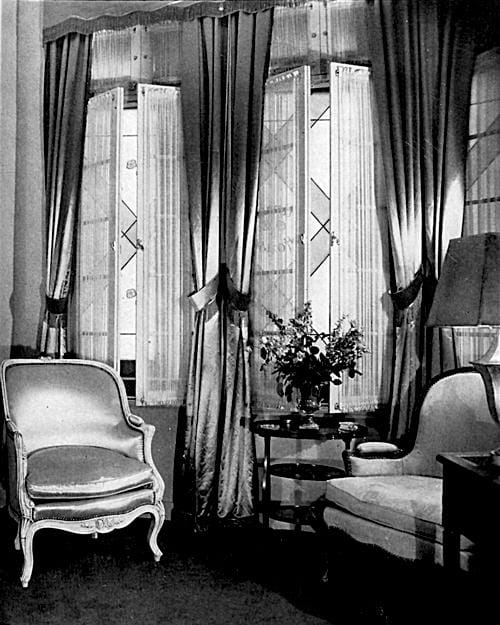
Above: 1929 Reception room at the new Primrose House salon at 595 Fifth Avenue, New York.
Given the banking connections of some of the original Lowell investors, the stock market crash of 1929 probably meant that money to invest in a major expansion of Primrose House evaporated then and, as far as I can tell, the company never managed to develop an extensive overseas market although its products did appear in a few overseas places in the 1930s such as Australasia.
1930s
Primrose House responded to the deepening depression in similar ways to other companies. The company did not completely refurbish its range but some products were repackaged, starting with Chiffon Face Powder in 1931. The company also updated its bottles in 1933 but kept the previous labels.
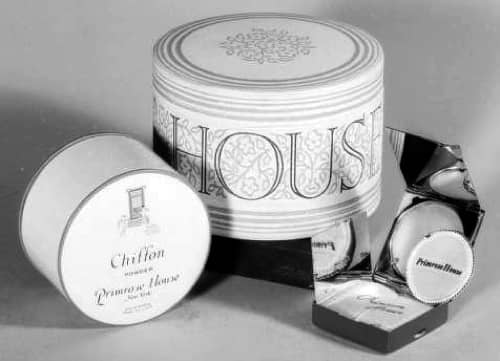
Above: 1934 Primrose House Chiffon Face Powder, Dusting Powder, and Compact. The Chiffon Dusting Powder box was introduced in 1933 while the Triple Compact, which came in combinations of Natural, Brunette, and Beige shades of face powder, and Raspberry, Medium, and Light shades of rouge, was added in 1932.
Primrose house also dropped the prices of a number of its products in 1933, most notably its Rose Leaf Cleansing Cream, and Skin Astringent. The shade ranges of some it its make-up lines were also reduced to help cut costs. For example, its Petal Bloom Finishing Lotion had its shades reduced to two — Natural, and Beige.
Primrose house also underwent a number of address and structural changes during the 1930s. In 1931, the New York offices of Primrose House were moved to 400 Madison Avenue and the Primrose House Sales Company (capital US$2,000) was established there in September, 1932. This was presumably done to reduce the tax the company paid under the Revenue Act of June, 1932. Other American cosmetic companies tried the same thing in the early 1930s, most notably Bourjois. After it became clear that the government was going to crack down on the idea, the Primrose House Sales Company was dissolved in 1935.
See also: Bourjois (post 1930)
The company’s manufacturing base at 16 Cooper Square, New York was enlarged in 1932 and Primrose House Laboratories, Inc. (capital US$2,000) was founded at 111 Eighth Avenue, New York in 1933.
During these changes the standing of the Primrose House line steadily depreciated. Primrose House was still stocked in department stores at the end of the decade but the company also introduced Delv in 1934. Delv was clearly meant to be mass marketed and Primrose House began aiming its advertising the lower end of the market as well. This was a long way away from where Helen Woodward had originally tried to situate Primrose House, but was perhaps closer to where the original investors wanted it to be.
At some stage Louis R. Wasey [1884-1961] acquired stock in the business through the Wasey Products Corporation, a company he had established in 1936. Wasey was the president of the Erwin, Wasey & Company advertising agency but also had significant commercial interests in the manufacture of a number of products including Barbasol (shaving cream) and Kreml (hair tonic). When his advertising company handled the accounts of these products, Wasey stood to make money both from product sales and advertising billings, a lucrative practice later followed by another advertising executive, Raymond Spector, when he took an interest in Hazel Bishop.
See also: Hazel Bishop
Skin-care
New skin-care products were added to the Primrose House range after 1930. The first one of importance was the previously mention Delv (1934), an all-round cream and powder base that was advertised as containing ‘Triactin’ – marketed as a youth-preserving ingredient – and lemon juice for ‘the daily care of the skin’.
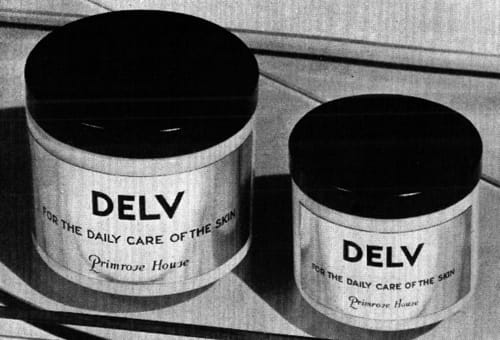
Above: 1934 Primrose House Delv all-purpose cream in two sizes. It was packaged in a white opal jar with a black screw-type lid. The gold foil label was printed with black lettering. The cream may have been developed by Dr. Louis J. Stern of the Post Institute. He experimented with the use of pituitary hormones and had previously been involved with the sale of Ultrasol, a ‘new hair-grower’ which contained pituitary gland extract.
In 1937, Delv Ltd. was created as a separate company specifically to sell Delv. The only reason I can give for this is that the investors hoped that Delv might at last provide them with a product that they could sell in large quantities. If so, they must have been disappointed. By the end of the decade, Delv appears to have been replaced by Chiffon All-Purpose Cream added to the Primrose House Chiffon range in 1940.

Above: Products from a 1930s Primrose House Introductory Set in bottles made by Hazel-Atlas. The Delv label differed from anything else in the Primrose House range.
Other notable additions were the development of Dry Skin Mixture (1936) and Chiffon (Cleansing) Cream (1937). Until 1936, women with Dry skin were recommended to use Rose Leaf Cleansing Cream followed by Primrose House Nourishing Cream to which a few drops of Smoothskin Oil (1928) had been added; a cumbersome practice. This routine was replaced with one that cleansed with Chiffon Cleansing Cream and then nourished with Primrose House Dry Skin Mixture. Smoothskin Oil continued to be promoted as a treatment for sun and wind-dried skin and hair and Primrose House also suggested it could be used in a hot-oil facial treatment.
Smoothskin Oil: “Dry skin welcomes it; in fact, it seems to drink it in.”
Dry Skin Mixture: “[A] blend of four oils never before combined in one cream. It is almost instantly absorbed. but it never leaves a hint of greasy residue for it is made with practically no base at all.”
Chiffon Cleansing Cream: “[A] blend of fine cleansaing and lubricating oils whipped into a marvelously light, fluffy consistency. … It cleanses the skin swiftly and thoroughly. It leaves no greasy residue. And it has remarkable softening qualities that help to refine skin texture.”
Chiffon All-Purpose Cream: “[T]he only cream you need to cleanse, help clarify and soften your skin.”
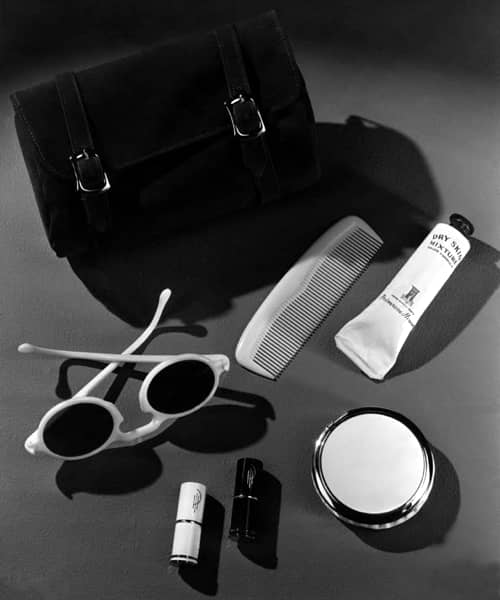
Above: 1937 Primrose House Ski Pack containing comb, glasses, a tube of Dry Skin Mixture, to be used before and after skiing, and a white pomade lipstick and powder in a pack small enough to strap onto a belt. The monogrammed lipstick cases introduced in 1935 were twist-up versions of the cases put on the market in 1931.
In 1940, Primrose House also made its Make-up Mask available to the general public. Before this it was only available as a salon treatment.
Primrose Make-up Mask: “Try this simple, effective pick-up treatment when you went to look your loveliest and time is short. Fluffy, fragrant, delightfully stimulating. It leaves your skin feeling so soft . . . so smooth . . . and all ready for make-up!”
Make-up
Primrose House Foundation Cream or Petal Bloom Finishing Lotion remained the main powder bases for Primrose House Chiffon Powder through the 1930s, Petal Bloom coming in five shades in 1940 – Natural, Beige, Rose Beige, Primrose Tan, and Bandana.
Chiffon Face Powder, most frequently advertised as ‘shine-proof’, continued to be the premier face powder in the Primrose House range right through the 1930s. It came in seven shades in 1930 – Natural, Brunette, Beige, Primrose-Tan, Rose Petal, Ivory, Orchid, and Dark. By 1938, this had become Natural, Brunette, Beige, Rose Petal, Rose Beige, Rachel, Dark Tan, and Daybreak. The Daybreak shade was dropped from the line by 1940 as peach shades were becoming less popular due to the fashion of suntanning.
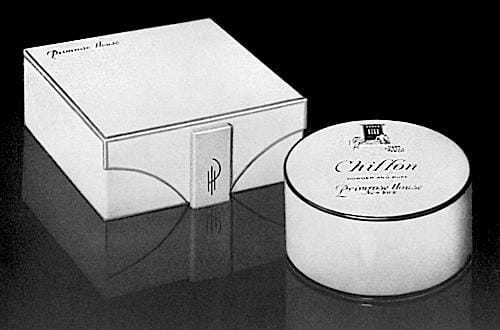
Above: 1934 Chiffon Face Powder in a new rectangular, pale lemon and silver box introduced in 1931 and a round box in two sizes.
The cheaper Primrose House Face Powder appears to have been renamed or replaced by Satin Powder by 1930 which only came three shades – Natural, Brunette, and Beige. I can find no trace of it later in the 1930s.
The introduction of more finely ground face powders in the 1930s by other companies intensified competition in the American face powder market. There was little Primrose House could do to match the fineness claims made by better-selling face powders, such as Lady Esther and Coty, except to say that its Chiffon Face Powder was ‘silk sifted’.
See also: The Bite Test
Some make-up products, such as a range of eyeshadow colours, were extended but the company’s make-up was still only available in a limited range of shades through most of the 1930s. For example, when a new soft, more permanent, non-greasy lipstick was introduced in 1935 in an embossed black case, it only came in Light, Medium, Primrose Red, Bright, and Dark shades. Later shades included: Bandana (1936); and Pompadour, and Carnival (1938).
The new Primrose House Chiffon Lipstick added in 1940 also only came with four shades – Chiffon Red, Medium, True Red, and Raspberry – before being extended with colours like Maraschino, Red Rouge, and Burgundy (1940), and Matador, Garnet, and Carnival Nite (1941). These came in matching cream and dry rouge but the colours did not extend to nail polish. Primrose House did sell a nail polish in the 1920s but it had gone out of production.
Wartime
America did not enter the Second World War until late in 1941 by which time the Primrose House salon had been moved to 379 Park Avenue where Leo of Primrose House offered hairdressing services.
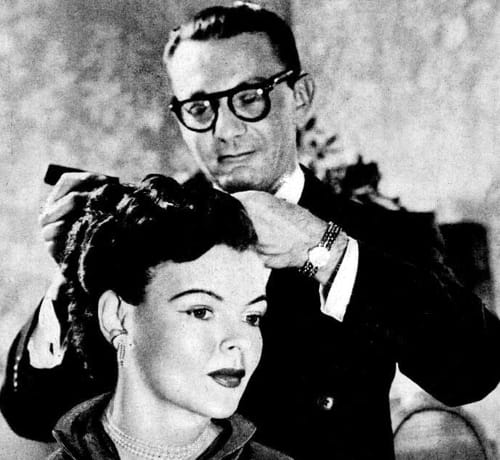
Above: 1949 Leo of Primrose House at 379 Park Avenue, New York.
Primrose House introduced a few new lines during the war including Forget-Me-Not Perfume, Hand Lotion, and Face Powder in 1942. These were extensions to the Forget-Me-Not range which had started with Forget-Me-Not Cologne, Dusting Powder, and Soap in 1940, and Forget-Me-Not Bubbling Bath, and Atomiser in 1941.
Other new make-up lines included Chiffon Make-up Base, a cream foundation, and Chiffon Liquid Hosiery, a stocking substitute (1943); and Petal Tint Liquid Cream Make-up in six shades (1944). Primrose House also developed Prim Deodorant Cream (1943), a deodorant/antiperspirant that used aluminium sulphate as its active ingredient, and Prim Shampoo (1944). The company had previously used the Prim name to badged its Prim Depilatory Cream, and Prim Depilatory Powder back in the 1920s.
Petal Tint Liquid Cream Make-up: “[S]preads a radiant pastel veil of smooth loveliness over your skin, hides every tiny line, yet you never look ‘made up’.” Shades: Natural, Beige, Rose Beige, Rose Petal, Brunette, and Bandana.
Chiffon Make-up Base: “[A] non-drying cream foundation to protect the skin and aborb perspiration, preventing shininess.” Shades: Light, Medium, and Dark.
Chiffon Liquid Hosiery: “[E]asy to apply, smooth finishing, waterproof, will not rub off.”
Prim Deodorant Cream: “[C]hecks perspiration for one to three days, and removes its odor . . . harmless . . . won’t rot fabrics or irritate normal skin . . . greaseless; dries and vanishes instantly.”
Post war
In 1945, Primrose House moved to new quarters at 724 Fifth Avenue in New York and the following year updated the packaging for a number of its lines in its Chiffon and Forget-Me-Not ranges.
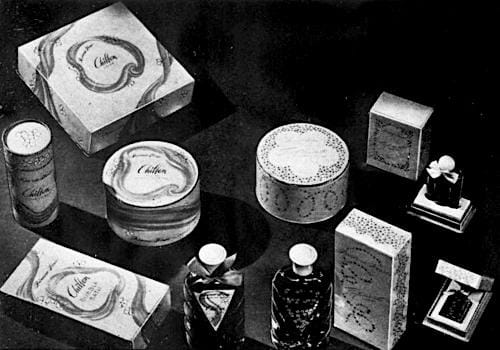
Above: 1946 Primrose House cosmetics in new packaging.
Skin-care
New skin-care lines started with Chiffon Smoothskin Lotion (1945), a lanolin-based, all-purpose lotion for hands, body and face.
Chiffon Smoothskin Lotion: “[A]n all-purpose, all weather lotion to help protect skin from wind, weather and work. Use it generously after bathing, on hands, elbows, arms, legs, knees, throat, face, the entire body.”
Other new lines included Estrogenic Hormone Cream (1946), Deep Pore Cleansing Cream (1948), and Chiffon Solid Hand Lotion (1953), a aqua shade stick that came in a purse size gold push-up, snap-cap case.
Estrogenic Hormone Cream: “[B]rings new youth, new loveliness to over 30 skin. Contains rich, beneficial natural hormones.”
Deep Pore Cleansing Cream: “[W]orks down deep and removes every particle of dirt and make-up from the pores. That’s why your skin appears so much brighter
and radiantly fresh even after the first application.”
Chiffon Solid Hand Lotion: “[C]]omes in convenient stick form,
and may also be carried in the purse. And it’s quick and easy to apply, too. Just three or four strokes to the back of the hand and that’s all!”
The Estrogenic Hormone Cream looks to have been introduced with 7,500 International Units (IUs) of natural estrogenic hormone but this was later increased to 15,000 IUs, the maximum allowable limit agreed to by the American Food and Drug Administration (FDA) at the time.
See also: Hormone Creams, Oils and Serums
Primrose House seems to have stayed away from most of the other biological fads – such as placental extracts and royal jelly – that were introduced into American skin creams during the 1950s but it was the first company to introduce an albumin wrinkle treatment into the United States. Debuting in 1952, Le Secret de Blanche Delysia was advertised as a ‘magic elixir for renewal of fresher, firmer and younger looking skin’ imported from Fance. Sales seem to have faded fairly quickly but this did not stop other companies from trying something similar in the 1960s.
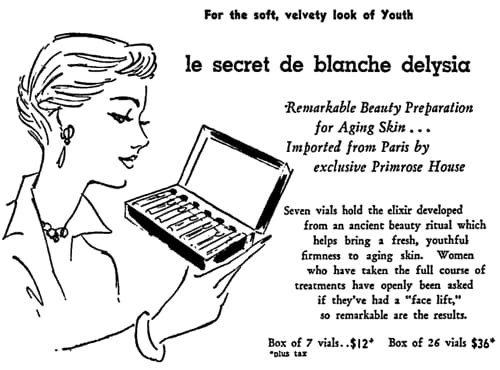
Above: 1952 Le Secret de Blanche Delysia.
See also: Albumin Wrinkle Smoothers
Make-up
In 1945, Primrose House introduced a new Chiffon Lipstick colour coordinated with a new nail polish in Spring-Up packages in shades that included Rose Petal, Red Rouge, Matador, Marschino, and Carnival Night. Unfortunately, I do not have any other records of new forms of make-up or additional shade ranges before the company was sold.
Fragrances
Primrose House added a new perfume called Witchery in 1946 before acquiring the distribution rights for Hartnell perfumes and toilet waters in 1953. It may not have held the Hartnell rights for long as I do not know if it retained them after the company was sold to Daggett & Ramsdell in 1955.
Daggett & Ramsdell
The increased use of expensive television advertising in America in the 1950s meant that smaller cosmetic companies like Primrose House had an increasingly difficult time if they tried to compete against the majors. Those at the lower end of the market were forced to compete largely on price.
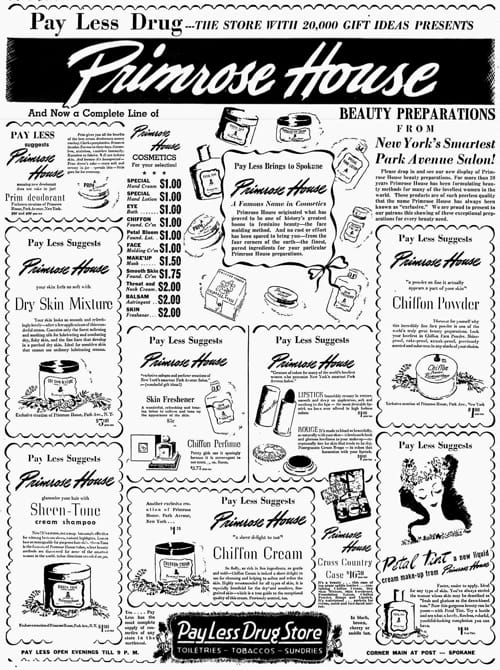
Above: 1944 Primrose House sold through the Payless Drug Store.
Louis Wasey retired from Erwin, Wasey & Company in 1956 and his withdrawal from business was associated with Daggett & Ramsdell taking over the manufacture, sale and distribution of Primrose House in 1955. Wasey also sold his interests in Barbarsol in 1956. Daggett & Ramsdell merged with the Barcley Corset Company in 1958 and Primrose House limped on for a number of years after this before going out of production sometime in the 1960s.
See also: Daggett & Ramsdell
Timeline
| 1921 | The Lowell Company established. Primrose House opens at 3 East 52nd Street, New York. New Products: Primrose House range. |
| 1926 | Primrose House reorganised and new management installed. |
| 1927 | Primrose House opens a branch at 127 Grant Avenue, San Francisco. |
| 1928 | Primrose House incorporates. Offices moved to 49 West 45th Street. New Products: Smoothskin Oil. |
| 1929 | Salon moves to 595 Fifth Avenue, New York. |
| 1931 | Offices moved to 400 Madison Avenue, New York. Chiffon Face Powder repackaged. |
| 1932 | Factory at 16 Cooper Square, New York enlarged. Primrose House Sales Company established. |
| 1933 | Offices moved to the Port Authority Commercial Building. New Products: Mascara. |
| 1934 | New Products: Delv all-purpose cream. |
| 1935 | Primrose House Sales Company dissolved. Lipsticks reformulated and released in a new case. |
| 1936 | New Products: Dry Skin Mixture; and Goggle Eye Cream. |
| 1937 | Executive offices moved to 111 Eight Avenue, New York. Delv Ltd. created to sell Delv all-purpose cream. New Products: Chiffon Rouge; and Chiffon Cream. |
| 1938 | New Products: Chiffon Perfume; Chiffon Cologne; and Chiffon Dusting Powder. |
| 1939 | New Products: Sun Screen Lotion; and Sun Screen Oil. |
| 1940 | New Products: Smoothskin Oil, Chiffon All Purpose Cream; Chiffon Lipstick; Make-Up-Mask; and Forget-Me-Not Cologne, Bath Powder, and Soap. |
| 1941 | Salon moves to 379 Park Avenue, New York. New Products: Forget-Me-Not Bubbling Bath, and Atomiser. |
| 1942 | New Products: Forget-Me-Not Perfume, Hand Lotion, and Face Powder. |
| 1943 | Beauti-Lashes and Beauti-Nails salon treatments introduced. New Products: Chiffon Make-up Base; Chiffon Liquid Hosiery; and Prim Deodorant. |
| 1944 | New Products: Petal Tint Liquid Cream Make-up; and Prim Shampoo. |
| 1945 | Primrose House moves to 724 Fifth Avenue, New York. New Products: Sheen-Tone cream shampoo; Chiffon Smoothskin Lotion; and Chiffon Cake Make-up. |
| 1946 | New Products: Chiffon Lipstick; Estrogenic Hormone Cream; and Witchery Perfume. |
| 1948 | New Products: Deep Pore Cleansing Cream. |
| 1952 | New Products: Le Secret de Blanche Delysia; and Chiffon Cologne Stick. |
| 1953 | Primrose House acquires the distribution rights for Hartnell perfume and toilet water in the U.S. New Products: Chiffon Solid Hand Lotion. |
| 1955 | Daggett & Ramsdell buys Primrose House. |
First Posted: 31st August 2015
Last Update: 27th October 2024
Sources
Coburn, F. W. (1920). History of Lowell and its people (Vol. 2). New York: Lewis Historical Publishing Company.
Peiss, K. (1998). Hope in a jar: The making of America’s beauty culture. New York: Henry Holt and Company.
Primrose House. (n.d.). Primrose House [Booklet]. New York: Author.
Woodward, H. (1926). Through many windows. New York: Harper & Brothers.
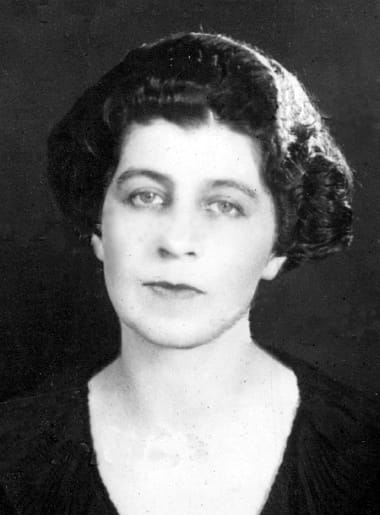
1922 Elsie Waterbury Morris [b.1884]. Like Helen Woodward she lived in New York and had a writer for a husband. This may have been the connection between them. Elsie divorced her husband, Gouverneur Morris, in 1922, so may have been looking for a new direction in her life.
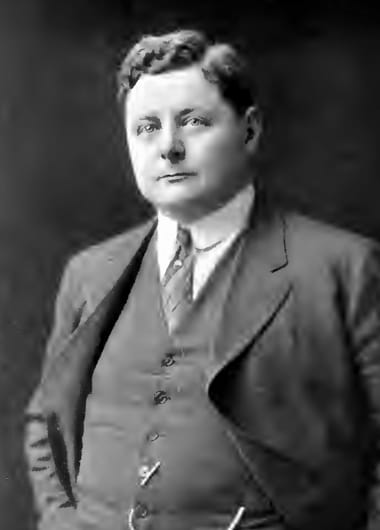
Robert F. Marden [1878-1935], banker and president of the Lowell Company.
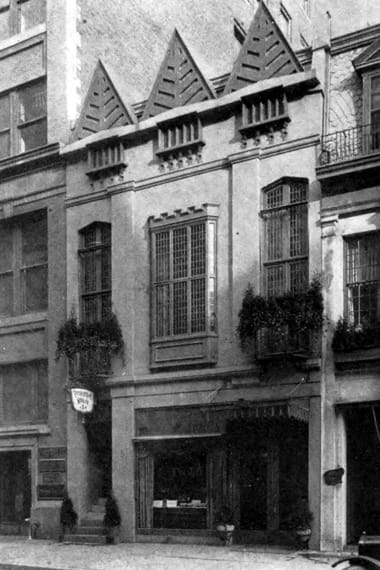
1922 Primrose House. The building, which still stands today, began its life as a stables in the 1870s. The facade, with its triangular dormers and Tudor-style leaded-glass windows, was added in 1913. They were designed either by G. Bovard MacBride, for the interior decorating business he ran there, or by the architect George Amouroux. The Primrose House redevelopment was handled by Elkin Wallick. Woodward noted that it was to “look as little as possible like a place where you spent money” (Woodward, 1926, p. 308). The exterior was painted in cream with green and vermillion features. The red door to the salon, with its overhanging Primrose House sign, is visible on the left. Most of the ground floor was taken up by tea rooms.
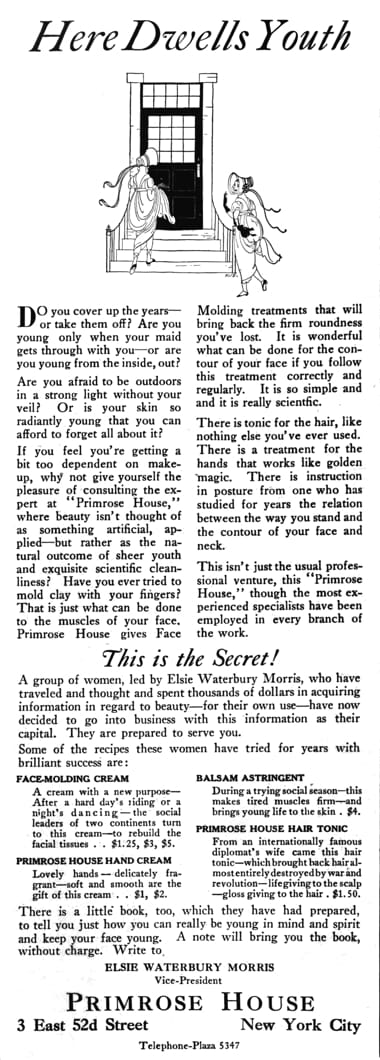
1921 Primrose House. The slogan ‘Here Dwells Youth’ and the red door to the salon appear frequently in Primrose House advertising.
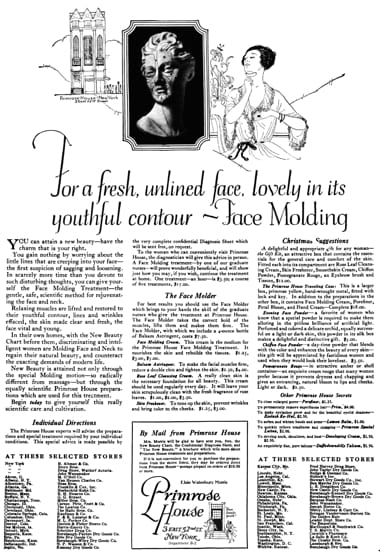
1922 Primrose House Face Molding Treatment. A wide number of outlets are now carrying its products.
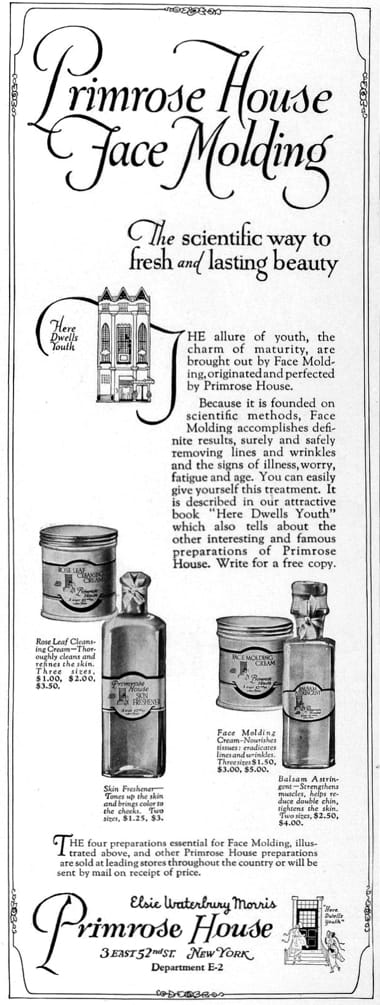
1924 Primrose House Face Molding Treatment Set.

1924 Primrose House Face Molding.
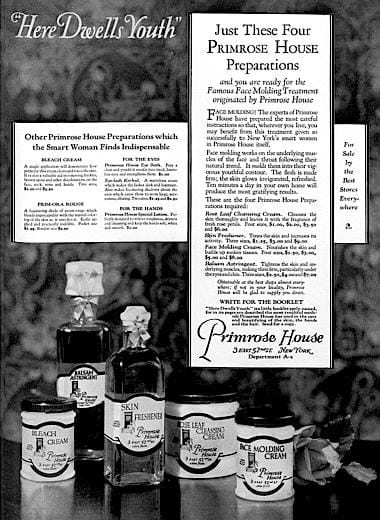
1926 Primrose House.
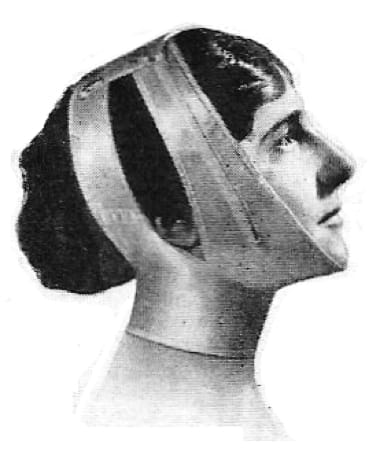
Primrose House Face and Neck Corrective Strap made from flesh coloured satin or French brocaded coutille. It was to be worn up to an hour each day but not at night so that the face could ‘breathe’.
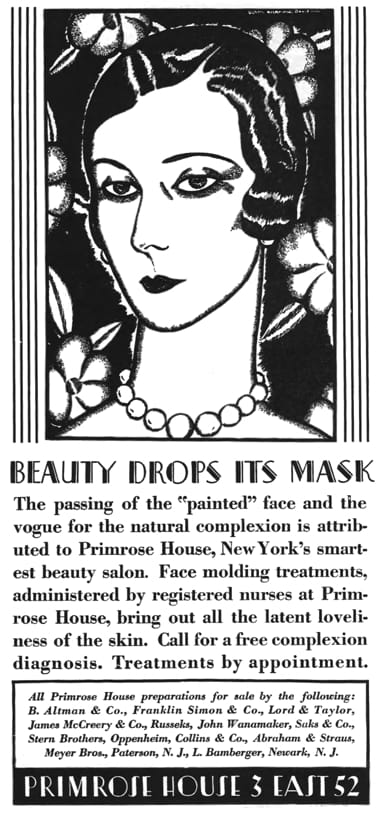
1927 Primrose House.
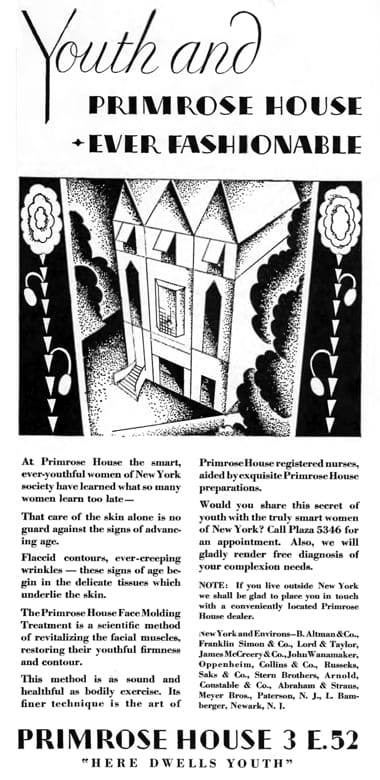
1927 Primrose House.
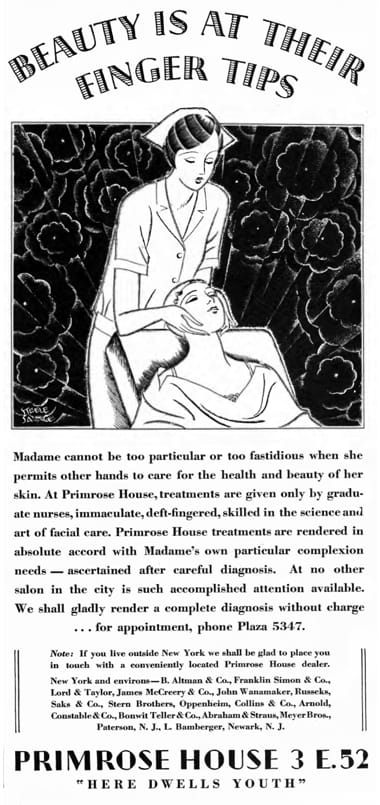
1928 Primrose House advertising the fact that nurses delivered their salon treatments.

1928 Primrose House compacts.
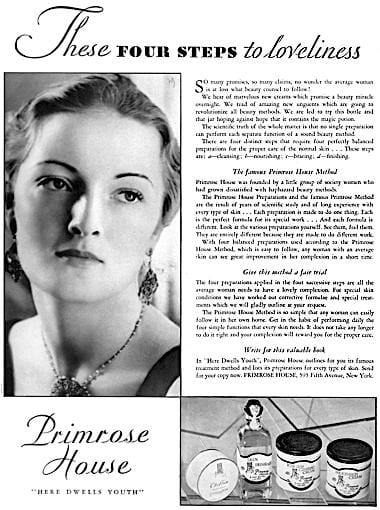
1929 Primrose House four steps to loveliness.

1929 Treatment room in the Primrose House salon on Fifth Avenue.
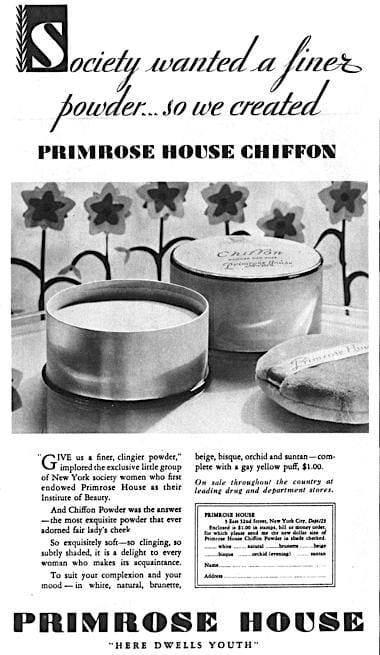
1929 Primrose House Chiffon Face Powder.
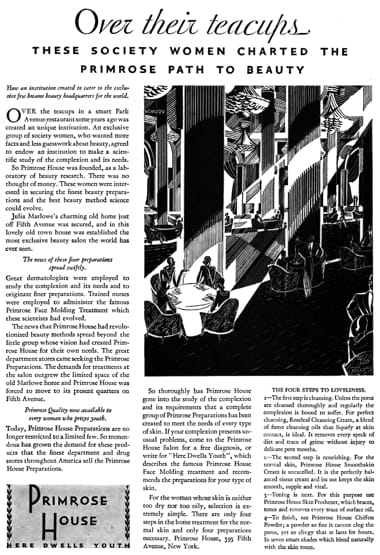
1930 Primrose House. Still pushing the snobbish line that the company was developed by society women even though Elsie Waterbury Morris had long since left the business.
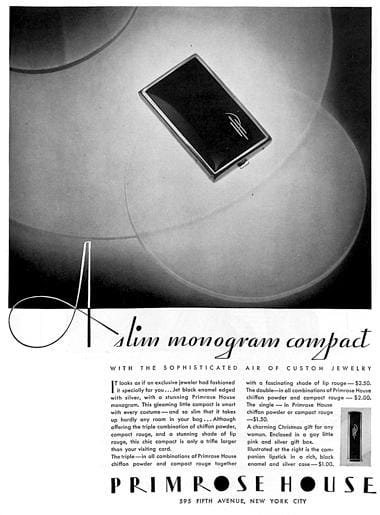
1930 Primrose House Monogram Compact and Lipstick.

1930 Primrose House. Four steps to loveliness.
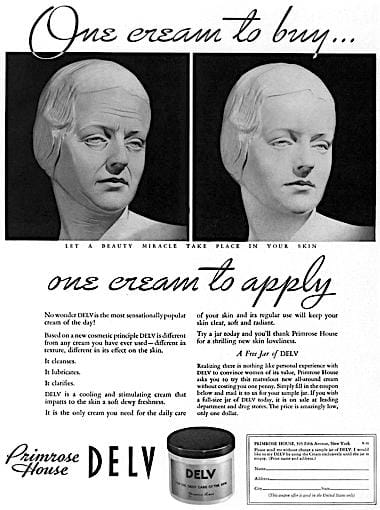
1935 Primrose House Delv.
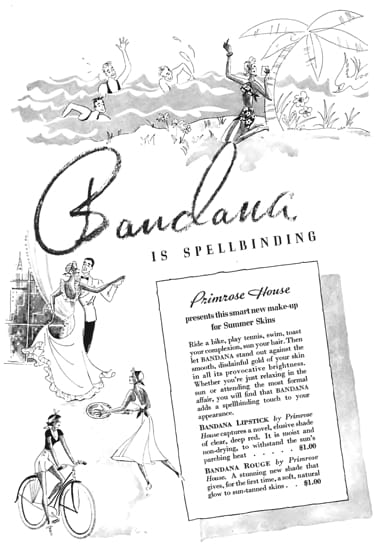
1936 Primrose House Bandana shade lipsticks and rouge.
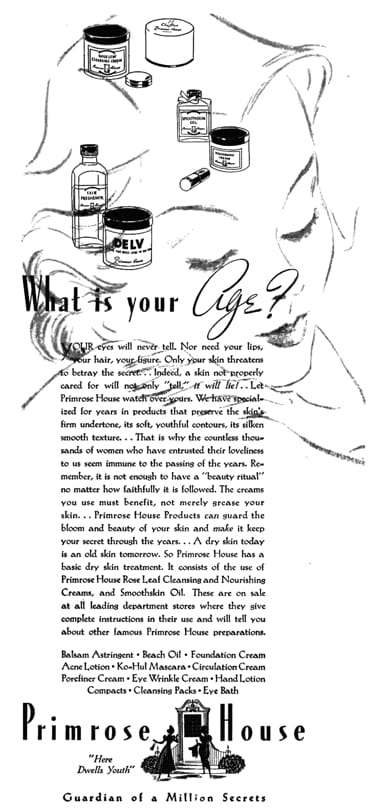
1936 Primrose House.
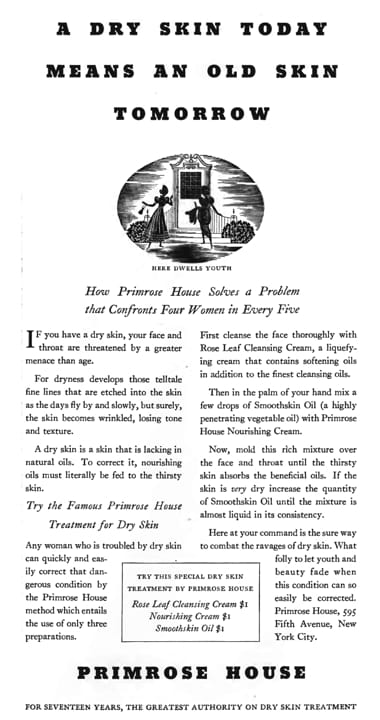
1936 Primrose House. This dry skin routine involved using Rose Leaf Cleansing Cream, Nourishing Cream and Smoothskin Oil. By 1937 this was no longer the case.
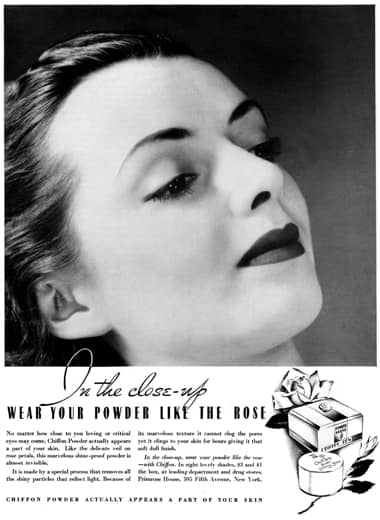
1937 Primrose House Chiffon Powder.
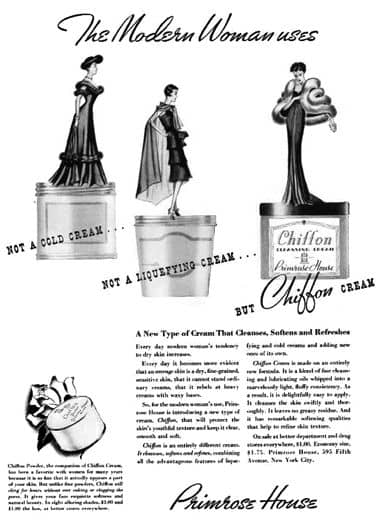
1937 Primrose House Chiffon Cleansing Cream.
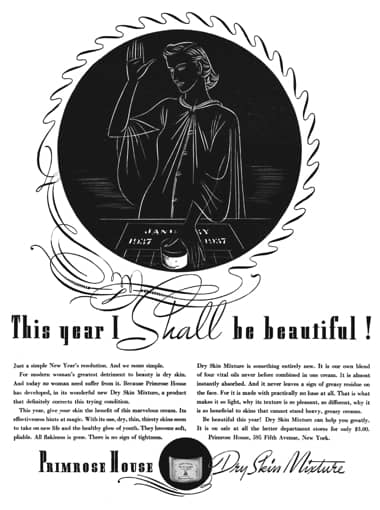
1937 Primrose House Dry Skin Mixture.
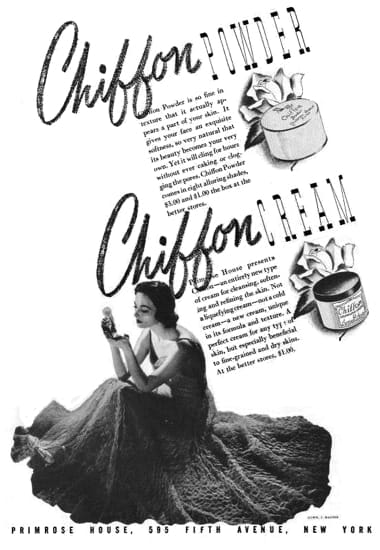
1937 Primrose House Chiffon Powder and Chiffon Cleansing Cream.
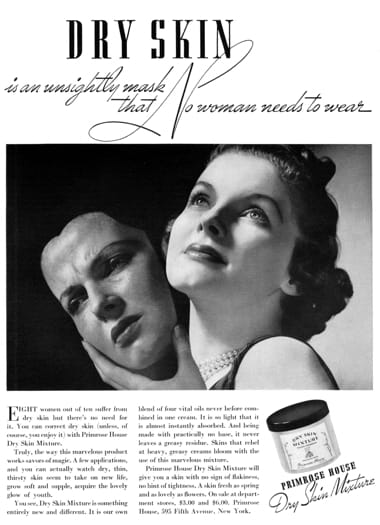
1937 Primrose House Dry Skin Mixture.
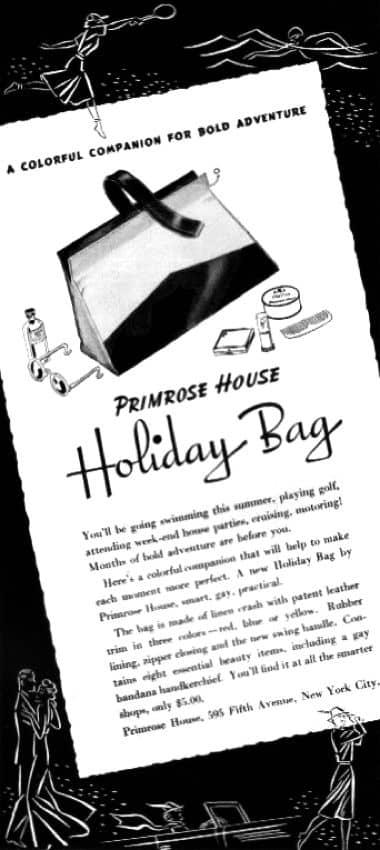
1937 Primrose House Holiday Bag.
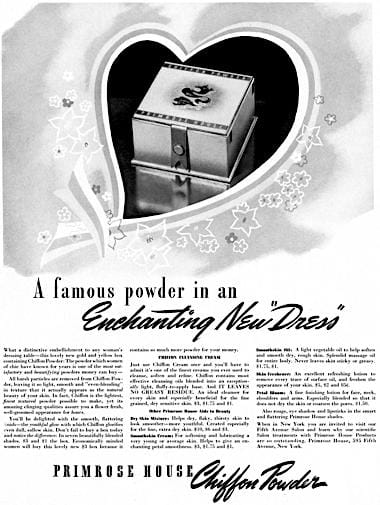
1940 Primrose House Chiffon Face Powder in new box.

1940 Primrose House Chiffon Lipstick, All-Purpose Cream and Powder.
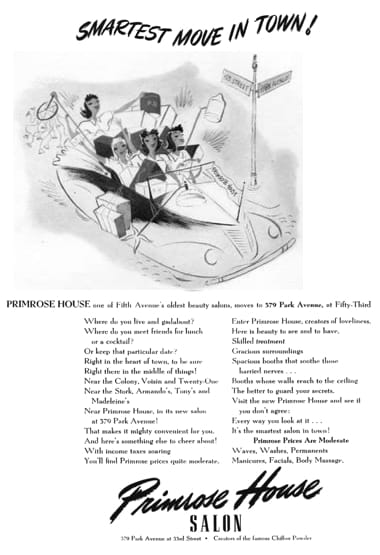
1941 Primrose House advertising the New York salon relocating to 379 Park Avenue.
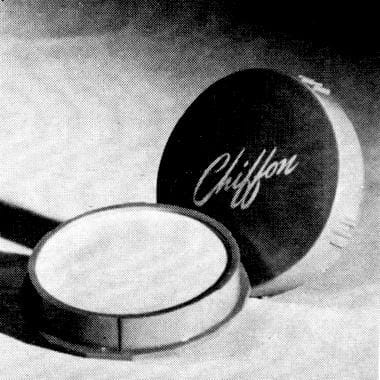
1944 Primrose House Make-up Base.
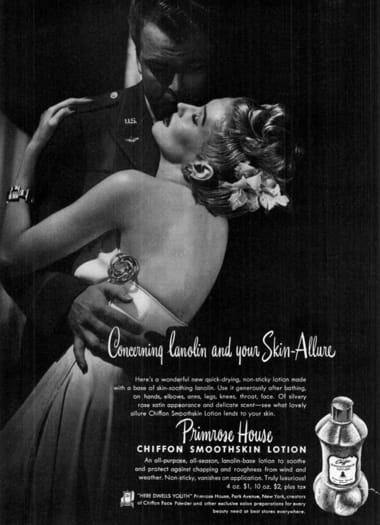
1945 Primrose House Chiffon Smoothskin Lotion.

Primrose House Chiffon Face Powder in a new box introduced in 1946.
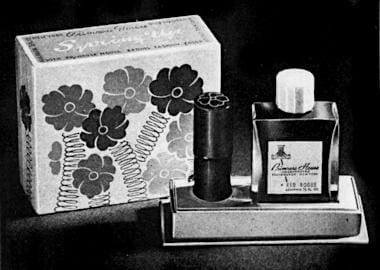
1946 Primrose House Spring Up lipstick and nail polish combinations.
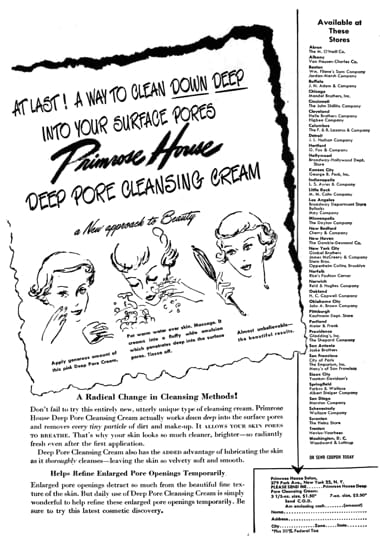
1949 Primrose House Deep Pore Cleansing Cream.

1955 Primrose House make-up as sold by Daggett & Ramsdell.

1956 Primrose House make-up as sold by Daggett & Ramsdell.
